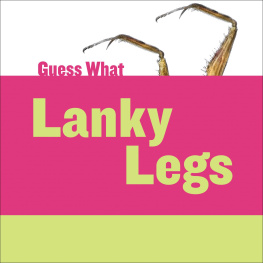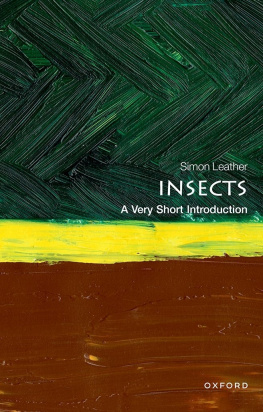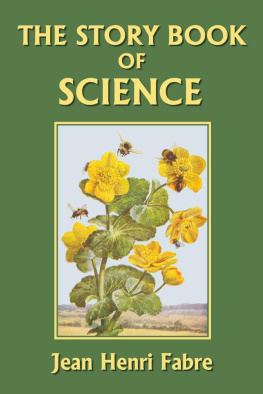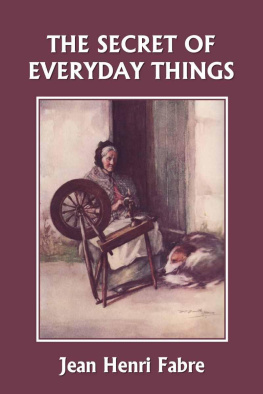Jean-Henri Fabre - Fabres Book of Insects
Here you can read online Jean-Henri Fabre - Fabres Book of Insects full text of the book (entire story) in english for free. Download pdf and epub, get meaning, cover and reviews about this ebook. year: 2013, publisher: Dover Publications, genre: Detective and thriller. Description of the work, (preface) as well as reviews are available. Best literature library LitArk.com created for fans of good reading and offers a wide selection of genres:
Romance novel
Science fiction
Adventure
Detective
Science
History
Home and family
Prose
Art
Politics
Computer
Non-fiction
Religion
Business
Children
Humor
Choose a favorite category and find really read worthwhile books. Enjoy immersion in the world of imagination, feel the emotions of the characters or learn something new for yourself, make an fascinating discovery.
- Book:Fabres Book of Insects
- Author:
- Publisher:Dover Publications
- Genre:
- Year:2013
- Rating:3 / 5
- Favourites:Add to favourites
- Your mark:
- 60
- 1
- 2
- 3
- 4
- 5
Fabres Book of Insects: summary, description and annotation
We offer to read an annotation, description, summary or preface (depends on what the author of the book "Fabres Book of Insects" wrote himself). If you haven't found the necessary information about the book — write in the comments, we will try to find it.
Fabres Book of Insects — read online for free the complete book (whole text) full work
Below is the text of the book, divided by pages. System saving the place of the last page read, allows you to conveniently read the book "Fabres Book of Insects" online for free, without having to search again every time where you left off. Put a bookmark, and you can go to the page where you finished reading at any time.
Font size:
Interval:
Bookmark:
OF INSECTS
(retold from Alexander Teixeira de Mattos
translation of Fabres Souvenirs Entomologiques
by Mrs. Rodolph Stawell)
Jean Henri Fabre
DOVER PUBLICATIONS, INC.
Mineola, New York
Bibliographical Note
This Dover edition, first published in 1998, is a republication of the work originally published by Dodd, Mead and Company, Inc., New York in 1921. While this book includes the unabridged text of the 1921 edition in its entirety, it does not contain the illustrations. A new Publishers Note has been written for this edition.
Library of Congress Cataloging-in-Publication Data
Fabre, Jean-Henri, 18231915.
[Souvenirs entomologiques. English]
Fabres book of insects (retold from Alexander Teixeira de Mattos translation of Fabres Souvenirs entomologiques by Mrs. Rodolph Stawell) / Jean Henri Fabre.
p. cm.
Originally published: New York : Dodd, Mead and Co., 1921.
ISBN 0-486-40152-9 (pbk.)
1. InsectsBehavior. I. Teixeira de Mattos, Alexander, 18651921. II. Stawell, Rodolph, Mrs. III. Title.
QL496.F13513 1998
595.7dc21
98-4171
CIP
Manufactured in the United States of America
Dover Publications, Inc., 31 East 2nd Street, Mineola, N.Y 11501
For more than 40 yearsafter his retirement from teachingthe French entomologist and belletrist, Jean Henri Fabre (18231915), devoted himself to studying the life history, habits, and instincts of insects through direct observation. His writings bring their mostly unobtrusive worlds alive with intricate detail and fascinating anecdote which enchant like a childrens fairy tale, despite their thoroughly scientific grounding.
Dubbed The Poet of Science by one of his biographers, as well as the Homer of Insects by his contemporary, Charles Darwin, M. Fabre is almost forgotten today in his native France, and nearly unknown in the United States. But in Japan he is regarded as a pioneer in the science of ecology where his opus is widely read in new multi-volume translations. He is revered there too for his rather unique perspective on nature which directly links art and science.
Jean Henri Fabris contemporary relevance is further enhanced by a recent British study on pheromones and insects which credits him with being the first to recognize the importance of smell in insect communication through his experiments with moths. Despite a potion of strong, noxious odors concocted to serve as an olfactory obstacle course, the male eggar moth was nonetheless able to detect the presence of the female solely from her scent.
Fabres Book of Insects (from his Souvenirs Entomologiques) provides a fresh outlook on these creatureson the wing and underfootwith whom we share the earth.
W e all have our own talents, our special gifts. Sometimes these gifts seem to come to us from our forefathers, but more often it is difficult to trace their origin.
A goatherd, perhaps, amuses himself by counting little pebbles and doing sums with them. He becomes an astoundingly quick reckoner, and in the end is a professor of mathematics. Another boy, at an age when most of us care only for play, leaves his schoolfellows at their games and listens to the imaginary sounds of an organ, a secret concert heard by him alone. He has a genius for music. A thirdso small, perhaps, that he cannot eat his bread and jam without smearing his facetakes a keen delight in fashioning clay into little figures that are amazingly lifelike. If he be fortunate he will some day be a famous sculptor.
To talk about oneself is hateful, I know, but perhaps I may be allowed to do so for a moment, in order to introduce myself and my studies.
From my earliest childhood I have felt drawn towards the things of Nature. It would be ridiculous to suppose that this gift, this love of observing plants and insects, was inherited from my ancestors, who were uneducated people of the soil and observed little but their own cows and sheep. Of my four grandparents only one ever opened a book, and even he was very uncertain about his spelling. Nor do I owe anything to a scientific training. Without masters, without guides, often without books, I have gone forward with one aim always before me: to add a few pages to the history of insects.
As I look backso many years back!I can see myself as a tiny boy, extremely proud of my first braces and of my attempts to learn the alphabet. And very well I remember the delight of finding my first birds nest and gathering my first mushroom.
One day I was climbing a hill. At the top of it was a row of trees that had long interested me very much. From the little window at home I could see them against the sky, tossing before the wind or writhing madly in the snow, and I wished to have a closer view of them. It was a long climbever so long; and my legs were very short. I clambered up slowly and tediously, for the grassy slope was as steep as a roof.
Suddenly, at my feet, a lovely bird flew out from its hiding-place under a big stone. In a moment I had found the nest, which was made of hair and fine straw, and had six eggs laid side by side in it. The eggs were a magnificent azure blue, very bright. This was the first nest I ever found, the first of the many joys which the birds were to bring me. Overpowered with pleasure, I lay down on the grass and stared at it.
Meanwhile the mother-bird was flying about uneasily from stone to stone, crying Tack! Tack! in a voice of the greatest anxiety. I was too small to understand what she was suffering. I made a plan worthy of a little beast of prey. I would carry away just one of the pretty blue eggs as a trophy, and then, in a fortnight, I would come back and take the tiny birds before they could fly away. Fortunately, as I walked carefully home, carrying my blue egg on a bed of moss, I met the priest.
Ah! said he. A Saxicolas egg! Where did you get it?
I told him the whole story. I shall go back for the others, I said, when the young birds have got their quill-feathers.
Oh, but you mustnt do that! cried the priest.
You mustnt be so cruel as to rob the poor mother of all her little birds. Be a good boy, now, and promise not to touch the nest.
From this conversation I learnt two things: first, that robbing birds nests is cruel and, secondly, that birds and beasts have names just like ourselves.
What are the names of all my friends in the woods and meadows? I asked myself. And what does Saxicola mean? Years later I learnt that Saxicola means an inhabitant of the rocks. My bird with the blue eggs was a Stone-chat.
Below our village there ran a little brook, and beyond the brook was a spinney of beeches with smooth, straight trunks, like pillars. The ground was padded with moss. It was in this spinney that I picked my first mushroom, which looked, when I caught sight of it, like an egg dropped on the moss by some wandering hen. There were many others there, of different sizes, forms, and colours. Some were shaped like bells, some like extinguishers, some like cups: some were broken, and were weeping tears of milk: some became blue when I trod on them. Others, the most curious of all, were like pears with a round hole at the topa sort of chimney whence a whiff of smoke escaped when I prodded their under-side with my finger. I filled my pockets with these, and made them smoke at my leisure, till at last they were reduced to a kind of tinder.
Many a time I returned to that delightful spinney, and learnt my first lessons in mushroom-lore in the company of the Crows. My collections, I need hardly say, were not admitted to the house.
In this wayby observing Nature and making experimentsnearly all my lessons have been learnt: all except two, in fact. I have received from others two lessons of a scientific character, and two only, in the whole course of my life: one in anatomy and one in chemistry.
Font size:
Interval:
Bookmark:
Similar books «Fabres Book of Insects»
Look at similar books to Fabres Book of Insects. We have selected literature similar in name and meaning in the hope of providing readers with more options to find new, interesting, not yet read works.
Discussion, reviews of the book Fabres Book of Insects and just readers' own opinions. Leave your comments, write what you think about the work, its meaning or the main characters. Specify what exactly you liked and what you didn't like, and why you think so.











